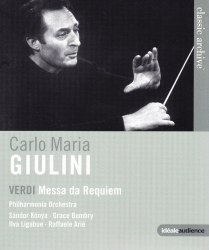|

|
Giuseppe VERDI (1813-1901)
Messa da Requiem (1873-4)
Ilva Ligabue (soprano); Grace Bumbry (mezzo); Sándor Kónya (tenor); Raffaele Arié (bass)
Philharmonia Orchestra and Chorus/Carlo Maria Giulini
rec. Royal Festival Hall, London, 26 April 1964
TV Format: NTSC 16.9 (Pillarbox), Black and white
Sound: PCM Mono on two channels.
Subtitles: English, German, French, Spanish, Latin
IDÉALE AUDIENCE Blu-ray 3079964 [90:00]
Verdi was not a religious man. Indeed, it is fair to say he was anti-cleric and particularly anti-Pope, as were many Italian Monarchists and Republicans. They held this view because of the activities of holders of the Papal Office during the fight for Italy’s unification and independence. Despite his personal views he wrote religious music.
A complex personality, Verdi could be irascible and stubborn, but also immensely compassionate when faced with the needs of others. He was also fiercely loyal to those he revered. Along with Rossini, the Italian he most revered and idolized was Alessandro Manzoni, the author of the novel I Promessi Sposi that he had read when he was sixteen. In later years he wrote “according to me, (he) has written not only the greatest book of our time but one of the greatest books that ever came out of the human brain”. The novel has been described as representing for Italians all of Scott, Dickens and Thackeray rolled into one and infused with the spirit of Tolstoy. It was not merely the nature of Manzoni’s partly historical story that gave the work this standing but the language. With it Manzoni made vital steps towards a national Italian language to replace the many dialects and foreign administrative languages present in the peninsula.
When Manzoni died in May 1873, after a fall, Verdi was devastated. He was so distraught he was unable to go to the funeral for which the shops of Milan were closed and the streets lined with thousands. The King sent two Princes of the Royal Blood to carry the flanking cords and they were aided by the Presidents of the Senate and Chamber as well as the Ministers of Education and Foreign Affairs. A week after the funeral Verdi went to Milan and visited the grave alone. Then, through his publisher, Ricordi, he proposed to the Mayor of Milan that he should write a Requiem Mass to honour Manzoni. This was to be performed in Milan on the first anniversary of Manzoni’s death. Unlike his failed proposal to honour Rossini in a similar manner, there would be no committee this time. Verdi proposed that he himself would compose the entire Mass, pay the expenses of preparing and printing the music, specify the church for the first performance, choose the singers and chorus, rehearse them and conduct the premiere. The city would simply pay the cost of the performance. Thereafter the Requiem would belong to Verdi. The city accepted with alacrity. It was Verdi’s eulogy to a great man of Italy and since then the work has often been referred to as “The Manzoni Requiem”.
At the time, and to this day, there is a debate about the nature of the music Verdi composed to honour his hero. Very different from the traditional ecclesiastical Catholic Requiem Mass, it is altogether more dramatic, even operatic, albeit set to the traditional sequence of movements and words of the Latin Mass. In general performances and recordings recognise the challenges and use operatic voices. In the stereo nineteen-sixties LP era and even into the age of the CD, two recordings stood out: that by Giulini on EMI recorded in 1964 and an altogether more dramatic one under Solti on Decca. Both were surpassed by Abbado later in the nineteen-seventies. The Giulini is widely regarded as being one of the more spiritual readings with its ethereally quiet opening, echoed here (CH. 2). In this 1964 video recording one can perhaps see why that might be the case in the manner of Giulini’s podium behaviour. He conducts without a score, often with eyes closed, hands governing every nuance of dynamic, until ready for the more tempestuous movements. These include the Tuba mirum (CH.4) when his eyes open to become mesmeric and his beat intense as he whips up the volume and tempo. Not all his singers are of the class of some on record. Grace Bumbry stands out but none of them let the side down although I would have preferred Bulgarians Ghiaurov or Christoff over compatriot Raffaele Arié in the Mors stupebit (CH.6). Ilva Ligabue is vocally elegant in the Libera me (CHs.19-21) whilst Sándor Kónya is tasteful in the Ingemisco (CH.11).
The double mono sound is not enhanced by the shoebox auditorium of Royal Festival Hall. The monochrome acoustic is clear and well focused but what is the description 16:9 (pillarbox) supposed to mean in respect of visual aspect? I have seen some re-mastering on to Blu-ray that has involved cropping and, via electronic means, providing a picture that fills a standard wide screen modern TV. The result with this disc is just like 4:3 with black borders down each side of the picture. On my Panasonic system, Q linked, I can normally choose to fill the screen using the TV aspect button if I wish, tolerating the over-tubby bodies of the singers. Not so here, the black border is there and a move to auto or 16:9 does not alter it as it does for 4:3 DVDs.
Robert J Farr
Previous review (DVD): Ian Lace
Masterwork Index: Verdi's requiem
Musicweb International Recommends:
Verdi's requiem
 |
 |
|
